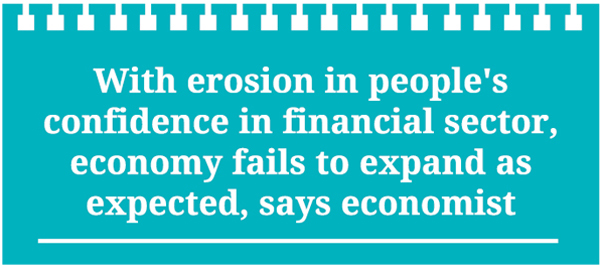 Bangladesh's financial sector saw a notable cut in its growth in the past fiscal year with two of its major constituents--- banking and insurance--- performing poorly.
Bangladesh's financial sector saw a notable cut in its growth in the past fiscal year with two of its major constituents--- banking and insurance--- performing poorly.
The lacklustre performance also impacted negatively the national gross domestic product (GDP) advances.
The growth in the financial sector-in the grip of severe volatility for several years now---in the fiscal year (FY) 2022-23 tumbled to 2.55 per cent in from 5.87 per cent in the previous fiscal, Bangladesh Bureau of Statistics (BBS) data showed.
Some major macroeconomic factors, like loan scams, soaring non-performing loans (NPLs), problems with interest rates and subdued demand for funds from the private sector amid slower economic activity, contributed to a substantial decline in the growth of the financial sector, experts say.
As such, the country's overall GDP growth contracted to 5.78 per cent coupled with a slower services-sector growth of 5.37 per cent in the last fiscal.
The slower growth in the financial sector has had a cascading impact on expansion of the services sector as well as the overall GDP growth in the FY2023, analysts said Friday.
Under the financial sector, the banking and insurance subsector's performance was bleak as their GDP contribution rate slowed down more than the others'.
According to the BBS, the country's financial-sector growth at constant price slowed to only 2.55 per cent in FY2023, from 6.04 per cent in the previous fiscal.
Performance of the financial sector was better in the FY'2021 after recovery from the Covid-19 invasion as the growth was recorded at 5.82 per cent in the FY2022, the official statistics showed.
The insurance-sector growth was recorded worst as it expanded at 1.08 per cent in the last fiscal in a slide from 3.14 per cent in FY'2022.
Among other subsectors, the growth in the miscellaneous fields, including nonbank financial institutions, also declined to 4.39 per cent in FY'2023 from 6.48 per cent in the FY'22, the financial GDP report of the BBS showed recently.
Earlier, all the financial subsectors had recorded decline in their growth rates in the fiscal year (FY) 2019-20. The subsector monetary intermediation had the worst time in many years.
Overall, the financial sector's contribution to the GDP, however, dropped only nominally during the period under review.
According to the BBS data, the financial subsector's growth dipped to 4.46 per cent in FY 2020 from 7.38 per cent in FY2019.
Its contribution to GDP was 3.39 per cent in FY2020, which was 3.42 per cent in FY2019.
Economists say the coronavirus pandemic hit hard banking-sector transactions in the last quarter of FY2020, but its growth should not have dropped by such a big margin.
The services sector's growth also dropped by 0.89 percentage points to 5.37 per cent in the FY'23 from 6.26 per cent in FY2022. But the rate in the financial intermediation subsector fell sharply by 3.32 percentage points year on year.
Economist Dr Masrur Reaz told the FE correspondent that the overall economic scenario had not been that satisfactory during the last fiscal as import declined, private-sector lending slowed down, non-performing loans increased, and deposit affected.
"Declining imports, falling revenue receipts, lower credit flow, higher NPLs, and bad condition of the capital market are the major reasons for the fall," he said.
Besides, the insurance sector has been affected as trade insurance has been affected due to import decline and erosion of income of the people amid higher inflation, Dr Masrur said, listing the adversities.
"With erosion in people's confidence in the financial sector, the economy did fail to expand at the expected rate over the years," says Dr Masrur, also Chairman of the Policy Exchange Bangladesh.
"Had the government been able to ensure good governance following different scams in the banking sector and falling reserves etc, public engagement in the financial market would have increased further," the economist adds.
An FE analysis has found that the GDP growth at the financial intermediations had started experiencing the decline since FY2018, which also persisted until FY2020.
In FY2017, performance of the banking subsector was the best in recent years, as it expanded at 9.12 per cent from that of 7.74 per cent in FY 2016, the BBS data showed.
Growth rate of the insurance subsector also recorded a fall by 0.91 percentage points to 4.05 per cent in FY 2020 from 4.96 per cent in the previous fiscal.
Similarly, growth of the other financial auxiliaries subsector also dropped by 2.07 percentage points to 9.48 per cent in the last fiscal compared to 11.55 per cent in FY 2019.
© 2024 - All Rights with The Financial Express
